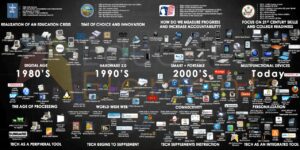This week during our EC&I 833 class, our presenters: Graeme Gieni and Michael shared an excellent video and history of audio-visual technologies and their integration and impact in education. I enjoy the episode. This reminded me of my old days.
“Empowering Education: The Transformative Impact of Audio-Visual Tools on Student Learning”
The utilization of audio-visual materials in education holds significant importance today as it enhances student learning. This growing reliance on audio-visual aids in teaching and learning stems from various factors. With the availability of such aids, students can now readily share knowledge and access information instantly. Moreover, learners can grasp ideas and concepts more efficiently. In the modern world, an array of audio-visual aids such as videos, music clips, flip charts, slideshow presentations, and overhead transparencies are readily accessible. These resources have become indispensable across educational settings, spanning from early childhood education to adult learning. By leveraging these resources, children have shown improved focus and retention of knowledge. As audio-visual technology continues to proliferate, it has transformed communication, allowing teachers to utilize these advancements to foster greater collaboration between teachers and students in the classroom.
“Adapting Education: The Tech Evolution in Classrooms and Remote Learning”
A year ago, numerous classrooms integrated fundamental audiovisual tools such as whiteboards, projectors, document cameras, speakers, computers, iPads, and apps like YouTube, as discussed in the presentation. However, with the onset of the COVID-19 pandemic in Spring 2020, education transitioned to a remote learning setup. This shift prompted the rapid uptake of more advanced tools known as fourth-generation tools. These tools encompassed video conferencing platforms like Zoom, Google Meets, and Microsoft Teams, as well as screen capture recorders, video editing software, and digital portfolios like seasaw. Many teachers experienced first-hand the challenges from not exposing their students to different forms of technology when they were forced to move teaching and learning online.
Utilizing teaching aids enhances teaching effectiveness, engages learners, and fosters a more participatory and knowledge-focused teaching-learning process. The integration of teaching aids is crucial for making the teaching-learning experience outcome-driven, straightforward, effective, and engaging for both educators and students. Especially when introducing new or abstract concepts that may pose challenges for comprehension, audio-visual aids play a vital role. They enable teachers to illustrate concepts that might otherwise be challenging to convey verbally. During my time teaching at a school in India, I encountered challenges with students grasping complex topics like photosynthesis, chemical compound nomenclature, and mole concepts. To facilitate comprehension, I frequently relied on audio-visual aids to simplify these concepts for the students.

Furthermore, individuals have diverse methods of processing, absorbing, and retaining information. For instance, some individuals are auditory learners, meaning they comprehend information better through hearing rather than reading. Conversely, visual learners prefer absorbing information through visual means. By incorporating audiovisual aids into their presentations, teachers can cater to multiple learning styles simultaneously.
How about: “Exploring the Magic of Sesame Street”

Introducing Sesame Street, the groundbreaking children’s TV program that revolutionized educational entertainment! Premiering in 1969, it set a new standard by implementing a detailed curriculum with specific educational goals. During its first season, Sesame Street embarked on an innovative promotional campaign aimed at families in low-income, inner-city areas, who traditionally didn’t engage with educational TV. Recognizing the need for tailored outreach, the show’s creators devised creative strategies to connect with these communities. As the series progressed, additional resources for preschool settings were developed, further enriching the educational experience for young viewers everywhere. According to a study published in the journal Early Childhood Education by Television: Lessons from Sesame Street, Sesame Street viewers, in particular those from lower-income areas, were found to be better prepared for school than their counterparts who did not watch Sesame Street. In comparison to their peers, children who watched Sesame Street scored higher on tests in science and English, had higher overall GPAs, read more books, valued achievement more, and were seen to be more creative.” Sesame Street stands out from traditional schooling: kids enjoy it, find it engaging, and it boasts high production value. While anecdotal, personal experiences and interactions suggest children may prefer it over classroom learning.” I am sharing an engaging video that demonstrates how children can learn about numbers.”
“…We now know that ‘Sesame Street’ encourages children to love school only if school is like ‘Sesame Street.’ Which is to say, we now know that ‘Sesame Street’ undermines what the traditional idea of schooling represents.” – Neil Postman
In this blog post, we’ll delve into the thought-provoking statement by Postman regarding Sesame Street. Before we dissect this quote, let’s first explore what exactly we mean by the “traditional idea of school.”
Sesame Street. Before we dissect this quote, let’s first explore what exactly we mean by the “traditional idea of school.”
Let’s talk about the traditional concept of school. As defined by Wikipedia, a school is a place where teachers guide students in learning. Now, the big question is: How does Sesame Street influence the learning spaces and environments for both teachers and students.
I came across an article by John S. Macnab that discusses two key concepts from Postman. First, it mentions how teachers’ roles have changed, now resembling entertainers more than traditional educators. Second, it talks about how the classroom, a social setting, has been replaced by solitary screen time, altering the learning environment.
The Responsibility of Teachers: As technology evolves, the role of teachers has shifted from being knowledge keepers to facilitators of learning. This change is evident from traditional schooling to modern platforms like YouTube. John S. Macnab emphasizes that altering educational media also alters our perception of educational value. Teachers must adapt, integrating new media into education while imparting essential skills for success in today’s dynamic society.
Shifting Social Dynamics in Education: Postman highlights how “Sesame Street” disrupts traditional schooling by replacing social interaction in the classroom with solitary screen time. Without opportunities for collaboration and critical thinking, classrooms risk becoming passive environments. It’s essential to ensure that technology integration serves a purpose, fostering skill development in communication, creativity, and critical thinking. By prioritizing meaningful engagement over passive consumption, we can maintain the social fabric of the classroom and cultivate vital skills for students’ future success.
What does this signify for modern education?

https://www.edelements.com/setting-the-context-a-brief-history-of-edtech
As we explore the integration of technology and audiovisual tools in classrooms, it’s crucial to recognize the transformative potential of educational TV programs like Sesame Street in shaping 21st-century education. Since Neil Postman’s 1985 work “Amusing Ourselves to Death,” education has evolved significantly. We now embrace technologies like Bring Your Own Devices (BYOD) and 1-to-1 classrooms, enabling interactive learning experiences through platforms like Kahoot, Quiz, and blogging, along with collaboration tools like Microsoft Teams. Even entertainment platforms like Netflix offer interactive content. As AV technologies evolve, education adapts accordingly. However, it’s essential to critically analyze learning with AV technology, allowing students time to connect and engage meaningfully. Particularly in the era of online learning, fostering relationships with students is paramount for effective teaching and creating meaningful learning experiences.
Finally, there are a few questions about Sesame Street that remain in my mind:
- How do we determine if Sesame Street effectively teaches children without a formal curriculum, assessment, or accountability for its performance?
- Are students tested or quizzed on what they learn from Sesame Street, and do they apply these skills in different contexts?

Feel free to share your responses to these questions in the comment box below.
See you in the next post!

Hi Navneet, your article provides a comprehensive exploration of the integration of technology and audiovisual tools in education, highlighting both the benefits and challenges. The transformative impact of programs like Sesame Street and emphasizes the importance of fostering meaningful engagement in the classroom is apt. Overall, your post offers valuable insights into the evolving landscape of education in the digital age, encouraging critical reflection on the role of technology in teaching and learning.